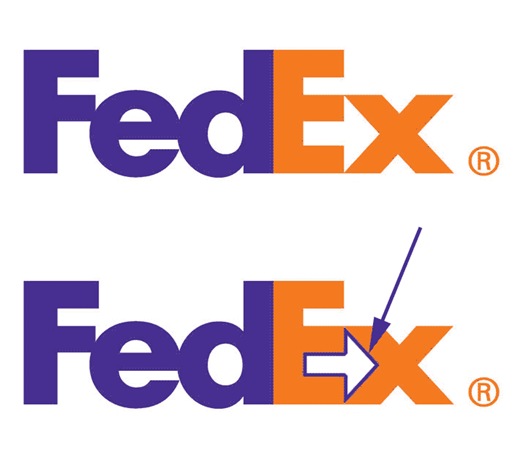
Detrimental area is just not a typical time period, however if you happen to spend any time learning firm logos or graphic design, you’ll hear it. “Detrimental area” is the area between and round objects in design. Proficient artists search for alternatives to create further that means or conceal Easter eggs when creating logos, selecting fonts, and spacing letters within the firm identify.
One of many extra well-known examples of adverse area is the FedEx emblem. The emblem’s design group realized that by selecting a particular font and letter spacing, they may create an arrow between the letters E and X. An arrow is the right image for a corporation that is at all times in movement delivering merchandise to clients. The story goes that on the first design evaluation, solely the CEO instantly noticed the arrow and the remainder of the group missed it. Perhaps, even in any case these years, you have got missed it as properly.
Many see what they count on to see and miss what’s staring them within the face. Since they don’t seem to be viewing issues in a full context, individuals expertise one thing just like the FedEx arrow and different negative-space objects as a blind spot. As soon as somebody factors out the adverse area, peoples’ blind spots often disappear in order that they will see the entire image.
Cybersecurity vs. the Blind Spots
Cybersecurity is rife with blind spots, however the penalties have extra severe impacts than lacking a hidden advertising and marketing message. In cybersecurity, there’s a fixed warfare to search out the subsequent assault, whether or not from financially pushed hackers or adversarial nation-states, earlier than it is too late. To counter these assaults, many firms do what they assume they’re purported to do: construct up a library of recognized assaults, additionally known as signatures. Then they evaluate community visitors or occasion logs to those signatures to attempt to match earlier occasions to what’s occurring now on the community.
This strategy was considerably profitable initially, however hackers rapidly assorted their assaults to keep away from matching recognized signatures. The cybersecurity trade responded with sample matching and complex makes an attempt to interpolate between what occurred and figuring out whether or not the assault intently resembles something they’ve seen earlier than. It is a statistical rolling of the cube, generally utilizing instruments like neural networks and the like.
Pursuing bigger and bigger signature and rule units comes with ballooning prices and runtime inefficiencies. Advertising and marketing tries to spin this as a great factor, pitching the largest, largest, or most advanced database (or information lake) of previous recognized signatures with a “greater is best” worth proposition. Weekly updates lend much more false assurance that you’re continually protected.
Zero-Days Undermine the “Greater is Higher” Strategy
The issue is that this strategy has a blind spot, which is that the unhealthy guys are utilizing adversarial synthetic intelligence (AI) to develop assaults that do not match historic signatures in any means and will not be detected with signature or signature-variant approaches.
These novel assaults are exemplified by the SolarWinds attack in late 2020 and different “zero-day” assaults, so known as as a result of they aren’t recognized earlier than they’re placed on the menace listing. Cybersecurity vendor FireEye said it couldn’t successfully alert on the SolarWinds assault as a result of the hackers “used a novel mixture of strategies not witnessed by us or our companions previously.” Due to this fact, the assault was capable of bypass its defenses.
So, how do you discover one thing if you do not know what it, or one thing near it, appears like?
Similar to the FedEx emblem, the reply is staring you within the face. The answer is to alter how you’re seeing every thing you’re looking at.
In cybersecurity, this implies with a view to determine threats you’ve got by no means seen earlier than, you have to change how you’re in search of threats. Somewhat than in search of what you assume is an assault, look at every thing that’s not regular conduct. If you happen to elevate what is not regular, you’ll look at all anomalies, together with assaults that you’ve and have not seen earlier than.
Similar to in actual life, generally seeing an arrow you do not count on will level you in the proper path.
Matt Shea serves as Head of Federal for MixMode, which is a “Third Wave AI” (by DARPA) firm with merchandise in cybersecurity. With over 20 years of expertise within the expertise area, Matt has concepted, architected, and developed groundbreaking options that mix … View Full Bio
Really useful Studying:
Extra Insights
